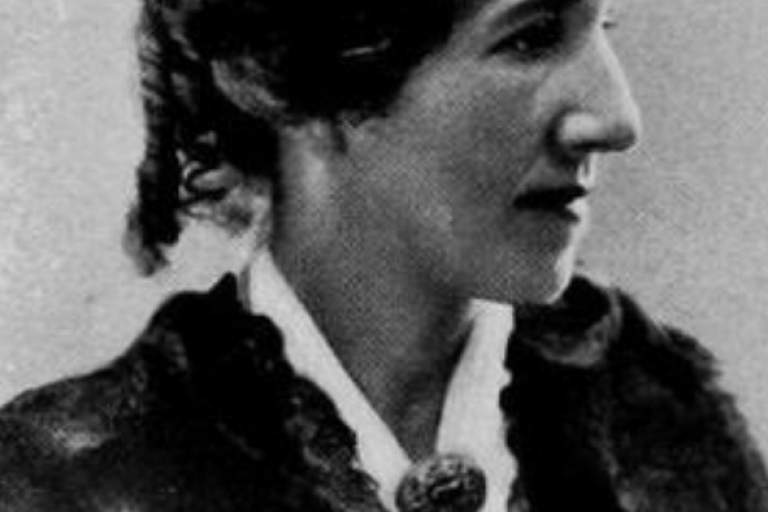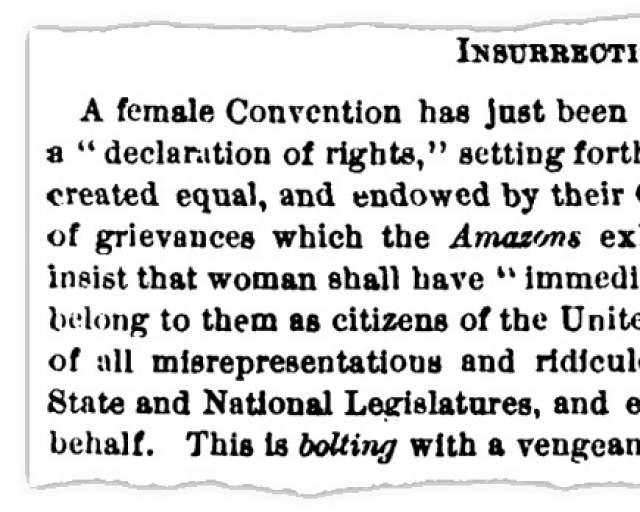
Catherine Ann Fish (1823–1904) was the daughter of abolitionist, Fourierist Utopian, and later Spiritualist pioneer Benjamin Fish. Some sources record her given name as Catharine. She grew up in Rochester, where she was educated in Quaker schools, gathered signatures for antislavery petitions, and urged male visitors to the Fish home to sign anti-tobacco pledges. In 1844, Catherine moved with her family to the Sodus Bay Phalanx in what is now Alton. The Phalanx was a short-lived Fourierist Utopian community, of which her father Benjamin was president.
Circa 1845, she met Giles Badger Stebbins (1817–1900), aged 28, a former resident of a Massachusetts Fourierist colony who had moved to Rochester. A close associate of leading Rochester abolitionists Isaac and Amy Post, his commitment to reform work echoed Catherine's own. The two were wed at the Sodus Bay Phalanx on August 17, 1846, her twenty-third birthday. Their wedding may have been controversial; Giles was a Unitarian and Catherine a Quaker. Some historians speculate that discord over this “mixed marriage” may have hastened the Phalanx’s collapse and Benjamin Fish’s departure from its leadership. But in fact, the Phalanx had already collapsed by the wedding date, and Benjamin had stepped down as its leader on April 17, having wound down the Phalanx’s tangled affairs. Holding the wedding there must have been a matter of sentiment for Catherine.
By December 1847, the Stebbins and Fish families had returned to Rochester. The Stebbinses organized a “Great Anti-Slavery Meeting” on behalf of the Western New York Anti-slavery Society. Catherine became secretary of the Rochester Anti-slavery Society. She and her husband took part in the Underground Railroad, collaborating with Frederick Douglass, Amy Post, and others in the area.
In 1848, the Stebbinses and Benjamin Fish all fell under the spell of the fraudulent Fox Sisters, taken in by their acts of apparent “mediumship,“ which actually relied on the young women's ability to pop their toe joints against the floor, producing supposed "spirit rappings." The Stebbins and Fish families were among the Sisters' earliest champions. Soon their fame spread worldwide, launching the Spiritualist movement. But the Stebbins and Fish families’ commitments to reform remained firm.
Catherine was also active for the cause of woman’s rights (nineteenth-century practice was to use the singular, woman's; later practice was to use the plural, women's). She attended the famous Woman’s Rights Convention at Seneca Falls, held in that village’s Wesleyan Chapel. There she was among the signers of its principal document, the Declaration of Sentiments. Two weeks later, she served as one of the secretaries of a Rochester woman's rights convention inspired by the Seneca Falls event. Her mother, Sarah D. Fish, also delivered an address to that convention.
In 1849, the Stebbinses moved to Detroit, Michigan. The couple traveled frequently, visiting west-central New York State and relocating as Giles’s employment (as an editor of reform periodicals) required. In 1869, Catherine was a founding member of the National Woman Suffrage Association, formed by Susan B. Anthony, Elizabeth Cady Stanton, and Matilda Joslyn Gage as the more radical wing of the suffrage movement. Catherine served on the organization’s executive board. Back in Michigan, she tried unsuccessfully to cast a vote in 1871 and 1872. Unlike Susan B. Anthony, she was not arrested for it. In 1876, she was a signer of the Women’s Declaration of Rights, a protest document which Anthony read at the Philadelphia Centennial Exposition (the first World’s Fair) on July 4, 1876.
In 1898, aged 75, Catherine became an editor of Elizabeth Cady Stanton’s Woman’s Bible.
She died in 1904 at an unknown location. She and her husband were buried in a family plot at Rochester’s Mount Hope Cemetery; the Stebbins plot is immediately adjacent to the family plot of Benjamin Fish.

Catherine Ann Fish Stebbins
Catherine Ann Fish Stebbins.
Associated Historical Events
Woman's Rights Convention at Seneca Falls
July 19–20, 1848
Follow-On Woman's Rights Convention
August 2, 1848








